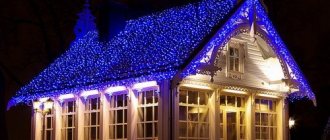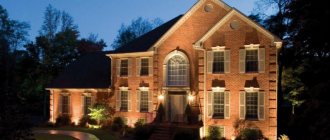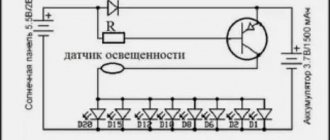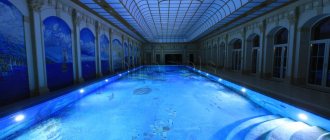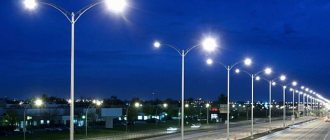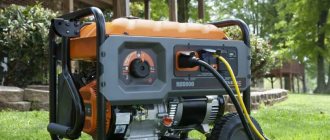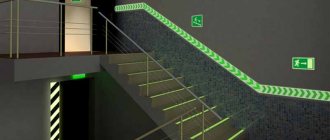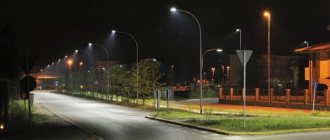Norms and requirements
When designing and installing street lighting in the yard, it is important to be guided by basic standards, which in the future will ensure not only the ease of use of the local area, but also human safety:
- In accordance with clause 6.3.1 of the PUE for external lighting devices in the yard, you can use lamps of any principle of operation with the exception of security alarm devices, in which the installation of gas-discharge equipment is not allowed
- The installation location of lighting devices can be organized both on free-standing supports and on structural elements of buildings, structures, on the ground, on cables according to clause 6.3.2 of the PUE . But when hanging on a rope in accordance with clause 6.3.4 of the PUE, measures must be taken to prevent them from swinging.
- In relation to the ground, in accordance with clause 6.3.6 of the PUE, you can choose any height, however, when installing yard lighting in the ground, you must provide the installation site with a drainage system.
- If the luminaire is located on any structures below 2.5 m in accordance with clause 6.1.15 of the PUE, their level of protection from dust and moisture must be at least IP54.
- In accordance with clause 6.6.8 of the PUE, the installation of lighting devices must ensure a sufficiently reliable degree of fixation.
- Based on the requirements of clause 6.6.1 of the PUE, the installation location of lighting devices in the yard should be chosen so that there is easy access to it.
- In the regulations of clause 6.6.4 of the PUE , suspended models with a flexible holder are lowered no lower than 1.5 m, otherwise anti-swaying devices are applied to it.
High Pressure Sodium Discharge Lamps
These most commonly used outdoor light sources were developed as an alternative to high pressure mercury discharge lamps. They have a high luminous efficacy of up to 150 lm/W, with a service life of up to 32,000 hours, and are used in almost all areas of industrial, commercial and street lighting, especially highway lighting. Their disadvantage is also insufficient color rendering, since all objects illuminated by them, except orange ones, appear gray and differ from each other only in shades.
Purpose of lanterns
The installation location of lamps in the yard is determined by the need to illuminate a particular area: the entrance, garden path, flower bed or pond. Depending on the tasks assigned, yard lighting devices can be divided into several categories.
Functional
The main task of functional lighting is to provide sufficient visibility in any area. Thanks to this type of lighting in the yard, you can ensure safe movement after dark.
Various types of lighting equipment can be installed for street lighting:
- Lamps and spotlights installed on the facade of a building or free-standing supports help illuminate garden areas, local areas, etc.
- Landscape street lights - characterized by low legs or direct installation in the ground, provide visibility of paths of buildings and structures in the yard.
- Floor lamps for street lighting are located at human height and are designed to illuminate a small area around, roads, driveways, entrances, gardens and other elements.
In addition to a powerful luminous flux, functional lighting must also ensure minimal energy consumption, so it is worth using LED lights here.
Security
Designed solely to prevent unauthorized entry of strangers into or near the yard. Used to illuminate any area of your home, space, area, etc. Constantly switching on the light at the entrance gate, fence or generally around the perimeter provides good visibility, but this is too expensive. Therefore, it is advisable to automate security lighting using a motion sensor, so that the lighting devices act as an alarm system, notifying that a person is approaching.
Decorative
Used to decorate the yard, its individual sections, flower beds, vegetation, ponds, stairs. Street lighting helps to effectively highlight important elements in the garden and act as architectural lighting. For decorative lighting, spotlights, spotlights, and LED strips are equally used. An important criterion when choosing specific equipment is its compliance with the landscape design and the general style of the buildings in symbiosis with which they will be used.
Festive
Festive courtyard lighting is intended to decorate the area for a specific event - New Year, birthday, etc. Unlike the previous type, they are installed temporarily - in relation to some holiday. Here you can also use architectural lighting, lighting paths, decorating gazebos and terraces. Garlands, LED strips and themed lamps are used as courtyard lighting devices.
Metal halide discharge lamps
Metal halide gas discharge lamps are a type of high-pressure mercury lamps, the glow in which occurs due to the emission of mercury vapor or decomposition products of halides. Metal halide lamps have a high luminous efficiency (110 lm/W) and are excellent sources of illumination for open spaces and communications. They are most suitable for use where there are high requirements for color rendering, or at critical points of road communications that require special color highlighting (pedestrian crossings, roundabouts). Their disadvantage compared to high-pressure sodium lamps is their shorter service life (about 20,000 hours) and high price.
Selecting suitable luminaires
It should be noted that the choice of lighting devices for suburban areas and private houses should be carried out according to three main criteria:
- installation height of lighting equipment in relation to floor level;
- angle of distribution of the luminous flux from the lamp;
- area of the illuminated area and surface of the object.
According to the type of luminous flux distribution, all yard lighting devices are divided into:
- common with diffuse flow;
- common with directed flow;
- local;
- hidden.
According to the method of location relative to the load-bearing and mounting structures, fastenings to the surface are divided into:
- Ceiling - the lamp is suspended from the upper plane of the building, on a support console, bracket, etc. It is good to install on terraces, under the roof at the entrance, near the walls of buildings.
- Wall-mounted – provide a smaller light distribution angle than the previous option, also suitable for entering a house, gate, illuminating the perimeter of a building, fences, building elements.
- Floor lamps - suitable for garden paths, platforms, entrances to the yard, etc.
- Recessed - cover a huge segment of lighting devices that can be mounted in walls to illuminate the facade, ground, ceiling and other surfaces, depending on your needs.
- On a short leg - used as decorative lighting of an area, paths or perimeter.
Selecting the lighting control type
Depending on the frequency of use, all yard lighting devices can be divided into devices with automatic and manual activation. The first method is relevant for those houses where the light in the yard should come on with the onset of darkness and go out with the first rays of dawn. If you want to control the lighting process yourself, it is better to install manual or mechanical switching.
Mechanical
To implement the mechanical switching on of lighting in the yard, key switches or contactors are installed. The first option is used for low-power loads, when one switch runs several LED lamps with low power. The contactor is used to switch powerful lighting in the yard when you have several lighting groups installed that create a large load. At the same time, you can divide all the yard lighting groups under several key switches or buttons if you run them using a remote control.
Automatic
Lighting automation allows you to eliminate the human factor as much as possible from controlling the switching process. This will allow you not to worry about lighting while you are away or eliminate the need to constantly turn on and off yard lighting.
To implement automatic backlighting, the following can be introduced into the power supply circuit of LED spotlights:
- photo relay - turns on the yard lighting when it gets dark;
- motion sensor - supplies power only when moving in a given area of space;
- time relay - allows you to set a program for turning on and off in a certain time interval (from a daily schedule to several minutes).
All of the above automation tools can be installed either separately or together. For this, a serial connection diagram is used, as shown in the figure below:
Light Emitting Diodes
Currently, the most dynamically developing area of lighting technology is LED lighting. Today, LED luminous efficiency is at the level of 200 lm/W, and their service life is 50,000 hours. Pleasant white LED light is distinguished by a fairly high level of color rendering, and the LEDs reach full brightness immediately after connecting to the electrical network without any delay or unpleasant flickering. Compared to gas-discharge lamps, properly designed LED luminaires can create sufficient and more uniform surface lighting, while consuming many times less electricity. The only obstacle to the widespread use of these unique light sources is their fairly high cost.
Nuances of electrical installation work
When installing and connecting lighting fixtures in the yard, several important nuances should be taken into account:
- Before starting work, draw up a yard lighting diagram linked to the site plan - this will save time and money spent on incorrect calculations.
- It is more expedient to lay the electric cable in the ground - this will preserve the aesthetics of the yard; the depth of its location should be at least 0.8 m.
- All lamps must have a quality certificate allowing them to be used outdoors. Otherwise, over time, the housing may collapse from exposure to atmospheric factors.
- The connection points and connections of the supply wires must be buried in a sealed box that prevents moisture from entering.
- Street wires running along the open part of the facades must be protected from exposure to sunlight.
- You can install solar-powered LED lamps, but you won't get much light from them.
Wiring and work procedure
First of all, it is necessary to draw up a detailed plan of the illuminated area, which indicates the placement of all lamps. Next, you need to develop a route that will connect those light sources that need power (except for those powered by solar panels). A separate circuit breaker must be installed in the electrical panel for street lighting. In some cases, several separate power lines may be required (for example, one for lighting the fence and the area in front of the house, and a second for the backyard).
Choosing a cable
It is advisable to lay the cable for powering the lamps underground. The minimum laying depth is 80 cm; it is advisable to use armored cable types. It is allowed to lay VVG cable, but in a protective sheath (special corrugated hose or asbestos-cement pipes).
In most cases, the cable for street lighting at home is laid underground
Air laying of cables for lamps is also allowed, but, firstly, it spoils the overall impression, and secondly, it is necessary to find a cable whose sheath is not afraid of ultraviolet radiation. These are certain types of polyethylene, the shells of which significantly increase the cost of cable products. Most often, VVG cable is used here, but it requires protection from ultraviolet radiation. It must be laid in cable channels (if they run along the walls of buildings) or corrugated sleeves. Without such protection, within a few years (3-4 years depending on the region), the shell will crack, which can lead to failure of the entire system.
Where to put switches
A few words about choosing the location for installing switches for street lighting at home. The system can be quite complex - there is a separate power supply to the lanterns on the fence, a separate branch for lighting along the paths, another branch for decorative lighting. But it is advisable to concentrate all switches inside the house, and most conveniently - near the front door.
The inconvenience of this scheme is that you need to turn the lighting off and on from home. This scheme can be made more convenient using a remote control system. But this is expensive equipment. It will be cheaper to install pass-through switches. They make it possible to turn on/off the light from two/three points. You can put one inside the house, the second one on the fence, near the garage, etc.

